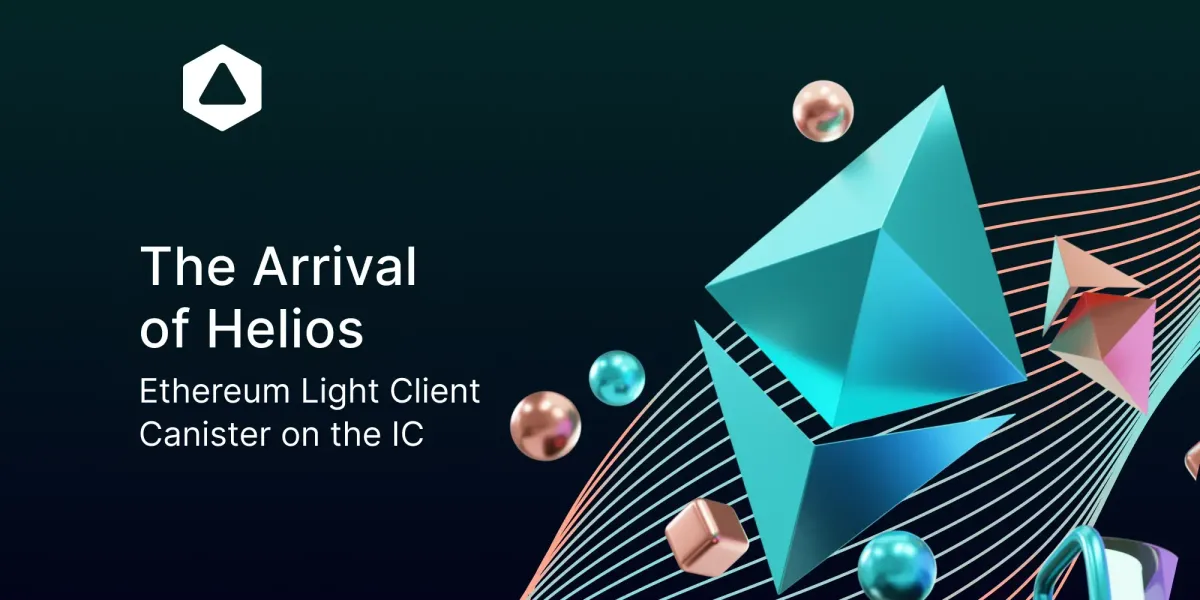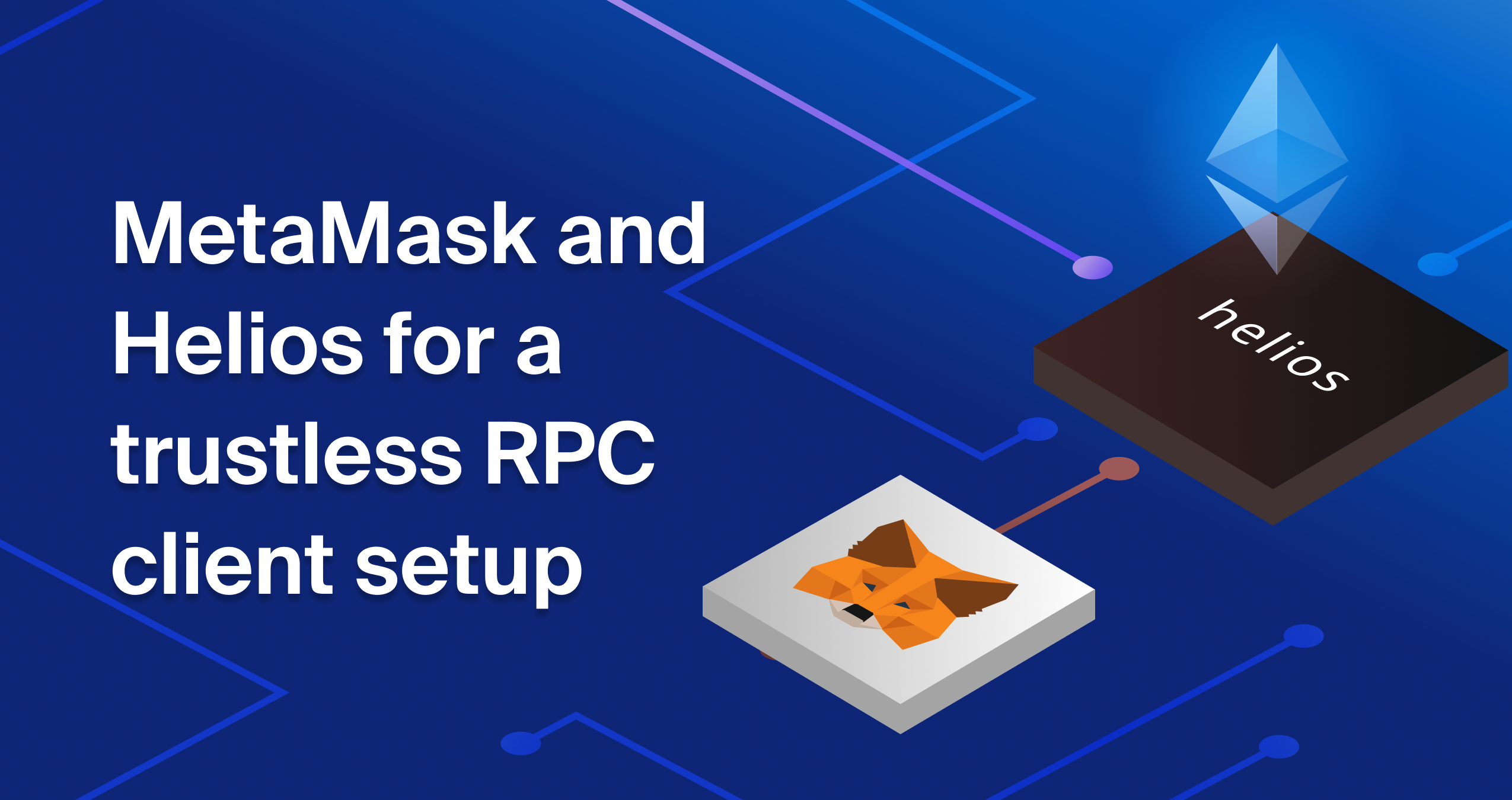The Arrival of Helios: Ethereum Light Client Canister on the IC
Delve into the concept of light clients, their importance, and explore Helios—a novel Ethereum light client for the Internet Computer

As the demand for efficient, secure, and scalable solutions grows, particularly for the Internet Computer, the use of light clients emerges as a crucial solution. These clients offer a streamlined way to interact with blockchain data. In this article, we delve into the concept of light clients, discuss their importance, and explore Helios—a novel Ethereum light client set to be available on the Internet Computer.
What is a Light Client?
A light client is a specialized software that allows secure interaction with blockchain data while requiring resources that scale logarithmically with the total blockchain state size. This means that as the blockchain grows, the data needed by the light client doesn't increase exponentially, but rather gradually, making it an efficient solution.
Particularly, this is ideal for resource-constrained devices such as mobile devices and browser extensions, as they can handle blockchain operations without excessive demand on their resources.
Why are Light Clients Needed?
Light clients are pivotal in enabling seamless blockchain experiences, particularly in resource-restricted environments like mobile devices or browser extensions. They facilitate cross-validation of data across different blockchains and provide trust-minimized access to Ethereum with significantly lower hardware requirements than full nodes.
This feature is akin to the Internet Computer's (IC's) Blockchain Ledger (BL) capability, which facilitates trustless synchronization from mobile devices to the IC. By empowering users to verify incoming data rather than rely on providers, light clients enhance network decentralization.
Merkle Proofs
Merkle proofs play a vital role for light clients as they enable data verification within a larger dataset while only requiring a logarithmic amount of data. They function by generating a Merkle tree, a system of hashes that links data to a trusted root hash.
These proofs supply the least number of missing nodes necessary to verify a piece of data against this established trusted root, thus enhancing the efficiency and security of light clients. Light clients bypass the need to validate every block header sequentially, leveraging validator voting information instead.
Helios Light Client Canister
Now that we know what light clients are and why they are needed, we can start understanding what exactly the light client of Helios is.
Helios is a novel Ethereum light client, constructed in Rust, that brings a trustless approach to accessing the Ethereum network. Unlike traditional light clients that depend on centralized nodes, Helios operates autonomously, maintaining its network state by validating chain headers against provided proofs.
As a light client canister, Helios engages with the Internet Computer network without requiring powerful hardware or active consensus participation. It downloads block headers and verifies them randomly, while relying on full nodes to retrieve additional data, thus offering an efficient and decentralized interaction.
Interoperability between Ethereum and the IC
By deploying the Helios Light Client to the Internet Computer (IC), we can establish trustless communications with the Ethereum network. This is a significant step in the realm of blockchain technology, as it paves the way for an interoperable ecosystem where both Ethereum and IC can coexist and interact.
This interoperability brings about a wealth of opportunities. It fosters cross-chain collaborations, expands the potential user base, and opens doors for creating innovative decentralized applications that leverage the strengths of both Ethereum and the IC. Furthermore, it introduces a new level of scalability, as the IC can handle large-scale computations while benefiting from the robust smart contract capabilities of Ethereum.
How is Helios Used?
Helios, a light client protocol, can be embedded into wallets, dapps, and other clients via WebAssembly to add trustless capabilities. Its direct integration not only protects users but also maintains portability.
Requiring minimal resources compared to a full node, Helios eliminates the need for a database. It's designed to track just the latest public keys and block headers, consuming only 20 bytes/second of bandwidth, without significant demands on storage or RAM. This lean resource usage makes it possible to integrate Helios for permissionless verification, even in hardware-constrained devices. Currently, Helios supports iOS, macOS, Android, and Expo platforms. The community is encouraged to contribute and enhance Helios further.
Integration Wallets
Wallets such as MetaMask, Trust Wallet, and Frame support custom RPC configurations. By adding a network using the Helios RPC endpoint to these wallets, users can ensure only verified data is used for transactions, providing trustless access to DApps and blockchain through the Internet Computer.
The Helios light client protocol opens the door for secure verification of balances and asset ownership, including NFTs, in wallets like the ones mentioned above, without the need to trust a single server. This provides a secure display of balances, verified against the true state root, enhancing trust and security in blockchain interactions.

Other Benefits
The integration of Helios into the Internet Computer enhances security by thwarting the potential for malicious nodes to supply counterfeit data, thereby reducing reliance on any centralized provider.
Final Thoughts
In conclusion, the advent of Helios, a novel light client, marks a significant milestone in blockchain evolution. By eliminating the need for centralized nodes and requiring minimal resources, Helios enhances blockchain's accessibility and security, especially for resource-constrained devices. With its streamlined, efficient, and trustless interaction with the Ethereum network, Helios fosters cross-chain collaborations and inspires innovation in decentralized applications. The deployment of Helios on the Internet Computer embodies a crucial step towards an interoperable ecosystem where Ethereum and IC interact seamlessly.

Connect with Bitfinity Network
Bitfinity Wallet | Bitfinity Network | Twitter | Telegram | Discord | Github

*Disclaimer: While every effort is made on this website to provide accurate information, any opinions expressed or information disseminated do not necessarily reflect the views of Bitfinity itself.


Comments ()